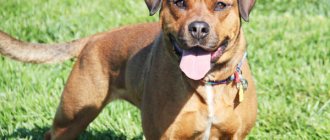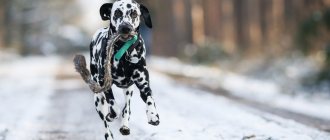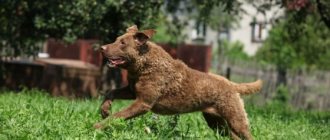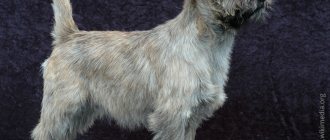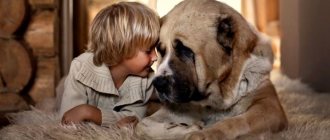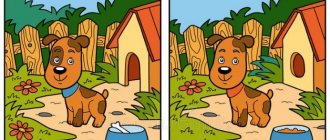The retriever is a type of hunting dog. Today this type unites 6 breeds, among which the Golden Retriever is especially popular. The name of the breed is of English origin and reflects its purpose - to find and deliver shot game to the hunter.
The retriever is a type of hunting dog
The Golden Retriever dog breed is good not only for hunting, but also in the everyday life of its owner. This breed is distinguished by high intelligence, good learning ability and a gentle character. The only thing it is not suitable for is guard functions. Let's get to know this dog breed better.
Origin of the breed and its standards
The origin of this type of dog is not a gift of nature, but the result of careful and planned selection. It was bred in the 19th century by the English aristocrat Sir Dudley Margerybanks, first Lord Tweedmouth, who was an avid hunter.
According to the personal records of Lord Tweedmouth, who carefully kept the stud book for over 50 years, the breed was started by mating a yellow retriever (the only light-colored puppy in a litter of black wavy retrievers) and a water spaniel (a now lost breed of hunting dog).
During the selection process, to improve quality characteristics, crossbreeding with other breeds of hunting dogs took place. It is reliably known that the Bloodhound and the Irish Setter participated in the development of this breed. Over the course of half a century, the breed was improved by selecting puppies for color, type and hunting ability.
The appearance is distinguished by a harmonious build, with correct proportions. The Golden Retriever breed has the following standards:
- the body is balanced and strong;
- the head is massive, but at the same time proportional to the body, with a convex skull and an elongated muzzle with flat cheeks, with a prominent transition from the forehead to the muzzle;
- the neck is muscular, of medium length;
- the eyes are widely spaced, brown in color with dark edges of the eyelids, which makes them expressive;
- the nose is black, quite large with wide nostrils;
- the jaws are strong enough to hold game without deforming it, the teeth are located vertically, the upper incisors tightly overlap the lower ones;
- Ear shape: hanging, medium length with rounded tips;
- The chest is wide and deep, the ribs are arched;
- the back is flat, turning into a muscular short loin;
- the tail is wide, located at the level of the back, without bends at the tip;
- the fore and hind limbs are muscular and strong;
- the shoulders are laid back, the shoulder blades are long, the elbows fit tightly to the body;
- hock joints are low, when viewed from behind, straight metatarsals can be observed;
- paws are rounded with thick, well-developed pads;
- the coat is thick, long, straight or slightly wavy, cream or golden in color, the undercoat is dense, waterproof;
- Males must have two well-developed testes, fully descended into the scrotum.
Diseases and life expectancy
Unfortunately, golden retrievers are not a healthy breed. They have a number of genetic abnormalities and are predisposed to cancer. They also often suffer from hip dysplasia and obesity.
The most common diseases include:
- hemangiosarcoma;
- lymphosarcoma;
- osteosarcoma;
- mastocytoma;
- hip dysplasia;
- epilepsy;
- raw eczema;
- diabetes;
- hypothyroidism;
- atopy;
- allergy;
- melanoma;
- laryngeal paralysis;
- cataract;
- glaucoma.
This breed is not suitable for owners who cannot pay for medical care.
On average, Golden Retrievers live 10-12 years.
Personality of a Golden Retriever
The breed has not only a golden color, but also a simply golden character. These are very smart, balanced, affectionate and playful animals, distinguished by their delicacy and intelligence. They have endurance and good instincts, are quite energetic, with excellent memory and intelligence, which simplifies the process of learning and training.
This species is absolutely not aggressive and does not require raising its voice, as it always strives to please its beloved owner. Friendliness and lack of tendency to dominate allows this breed to get along with both unfamiliar people and other animals. They love to communicate with small children, who will never be harmed.
The origin of this type of dog is not a gift of nature, but the result of careful and planned selection. It was bred in the 19th century by the English aristocrat Sir Dudley Margerybanks
In terms of intelligence, it is one of the smartest dogs; according to this indicator, it is among the top five out of 133 representatives of other breeds. This quality makes the training process easier. Intelligence, obedience and high susceptibility to training allow this breed to be used not only for hunting purposes, but also in the professional activities of such services as customs or police (to search for prohibited substances and objects), in rescue services (to search for people under rubble). The dog copes well with the role of an assistant for people with disabilities.
The disadvantages of this type are:
- dog hair is a strong allergen;
- gullibility: this breed will not make a house guard;
- high price.
Character traits
If you describe the Labrador’s character in two words, it would be like this: a peace-loving intellectual. Indeed, this description contains the main character traits of this breed. In addition, they are very cheerful, cheerful, always ready to play and very trusting, even naive.
About the game! Labradors love to run, jump, and swim. By the way, Labrador is the only dog breed in the world that has webbed feet, which allows them to swim well. If a dog finds a puddle on its way, it will not pass by, but will definitely splash in it. Don't even try to scold your pet for turning over a bowl of water.
Labrador puppies need training from the first months of life, since in their simplicity they can be stolen by anyone who lured them into play.
They lack the makings of a leader, which proves their “cooperation” with cop dogs. Labradors are smart and have excellent reactions.
The spontaneity and good nature of these dogs can charm even those who do not love dogs.
Varieties of the Golden Retriever breed
At the moment there are three types of this breed:
- The American Golden Retriever is taller at the withers and not as stocky as its European counterpart. According to American standards, the coat color should be strictly bright gold and rich, very light or dark shades are undesirable. Recently, some US breeders have been crossing American and European breeds, since the American type is more prone to cancer compared to its European counterparts. But it should be noted that in this case the animal’s exterior suffers and, accordingly, the cost of such dogs decreases.
- The European standard allows coat colors of all shades of gold or cream, with the exception of red and its tones. In Europe there are not just many light-colored representatives of this breed, but white color is quite common. In terms of body structure, European representatives are heavier, their chests are deeper, and their legs are shorter. The muzzle is also shorter and wider than that of their representatives from Canada and the USA.
- The Canadian Golden Retriever is a new generation with a medium coat color between the American and European breeds. The dog differs from the European type in darker shades and less dense coat. Like the American type, this dog is taller and slimmer than its European counterparts.
Care and maintenance
In general, these dogs are not whimsical, but the Golden Retriever breed needs coat care. It involves regular brushing, especially during shedding (otherwise hair will remain around the house and on your hands and clothes). Although goldens love to swim, they should only be bathed when necessary. It is also worth regularly examining the ears, since the hanging shape makes them more susceptible to otitis media. Among other things, constant walks are mandatory for these dogs; active dogs cannot be chained and not walked.
Feeding
One of the first questions that arises for a novice dog breeder is feeding a golden retriever. Since the diet for this breed is no different from the diet of other dog breeds, we recommend reading general articles on this topic (feeding natural food):
- What to feed a puppy depending on age (+feeding schedule);
- What to feed your dog at home (that is, from natural food).
Dry food for golden retriever
Reviews from owners of golden retrievers about Nero Gold food are good.
If you are going to feed your Golden Retriever with ready-made food, then first of all you need to understand the division of food into classes. To do this, read the article about classes of dog food. From it you will not only learn that economy feeds (Pedigree, Our Brand) are far from being as good as they say in advertising, but also why this is so. The good ones are super premium food and holistic food for dogs. Follow the links to find a complete list of brands belonging to each class.
Reviews of several good brands:
- Dog food GO customer reviews, composition, price and where to buy;
- Orijen dog food reviews and composition overview, price and where to buy;
- Dukes Farm dog food customer reviews, composition and price.
Diseases and their treatment
In general, the breed is healthy, but sometimes its representatives suffer from hip dysplasia, so if your pet loved to jump and suddenly stopped, he may have been exposed to this disease and should contact a veterinarian. In some cases, the Golden Retriever can be treated at home, for example, for sores typical of dogs. By visiting the “Veterinary Medicine” section, you will learn how to remove fleas from a dog, what to do if a dog has diarrhea, how to treat ringworm, when to vaccinate against rabies, and much more.
Golden Retriever Training
Do you want not only a kind, but also an obedient pet? — Then training a golden retriever is a mandatory procedure. Teach your dog at least basic commands (come towards me, next to me, sit) and your walks with him will never turn into a nightmare. Read more about this topic in the article on how to teach a puppy commands, where there are also video lessons on training each specific command.
The video above shows perfectly what results can be achieved by training a Golden Retriever. So don’t be lazy and start teaching your pet commands from puppyhood.
Gallery: Golden Retriever dog (25 photos)
Black flat
The Flat-Coated Retriever (Flat) is a hunting dog. His pedigree is a mix of Labrador, spaniel and collie breeds. The Flat differs from its golden counterpart by its straight coat and black color. According to the International Canine Association, there is an approved standard and appearance that all breeders of this dog are guided by.
Dossier
Height of an adult: height of adult males at the withers - from 59 to 61 cm, females - from 57 to 59 cm. Weight: from 25 to 36 kg. Characteristic color: dark chocolate brown or black. Coat length: medium, straight with a characteristic silky sheen. Life expectancy: 10-14 years. Advantages of the breed: intelligent with high working qualities. A great companion dog. Difficulties of the breed: affectionate, sensitive, difficult to cope with separation or change of owner. Average price: 90-100 dollars. Classification: medium breed from the group of retrievers, spaniels and water dogs. Refers to hunting.
Theses
- The breed was bred in the mid-19th century to solve specific hunting problems.
- A distinctive feature of the breed is its color; dogs can be liver or black in color.
- They perform well on the hunt and are valued by real hunters. But they are not very common as pets in the CIS countries.
- Flats have a soft, good-natured, playful character.
- They get along well with children, but they are quite large and can inadvertently knock a child down.
- Like all hunting breeds, they are very energetic and tireless, long walks are necessary.
Purpose and hunting with a straight-coated retriever (flat)
The Flat-Coated Retriever is endowed with all the qualities and abilities of a gundog. Compared to Goldens or Labradors, he is faster, more maneuverable and resilient. As befits a retriever, he simply loves water and is a very professional swimmer and diver. Smart and attentive, he skillfully scares away a bird within a shot. In addition, his keen sense of smell and resourcefulness allow him to quickly find game on land and in water. Adapts quickly to changing circumstances and will work equally well with owner, trainer or guest.
The Flat-Coated Retriever is a tireless, passionate hunter, an unsurpassed fetcher and tracker who is always ready to work.
It is worth noting that in terms of hunting use, flats are more versatile than other retrievers. They easily learn to work by following the blood trail, try to be the first everywhere and always, but their main quality is complete solubility in the owner. Flat is multi-talented and can be an athlete or a service dog. The most suitable disciplines for obedience and agility: agility, obedience, flyball, dancing with dogs. In service dog breeding, the work of a search dog or a guide dog suits him.
Advantages and disadvantages
A versatile, intelligent working dog with many talents, stable, sociable, friendly to everyone at home. The straight-haired is considered the most active among other retrievers, agile, intelligent, with lightning-fast reactions.
These active, hard-working animals constantly need something to do. They are ready to hunt, search or play something constantly. The Flat-Coated Retriever remains a good-natured, gentle, cheerful dog until old age . They are usually very friendly, so using fletts as guards will not work.
According to reviews from owners of straight-coated retrievers, this breed has virtually no disadvantages. Character – easy to train, affectionate, loyal. The appearance is balanced - elegant and powerful at the same time. The only negative is that sometimes there are “too many” pets. A lively temperament constantly forces the dog to look for more and more new adventures.
Caring for a Golden Retriever Puppy
When purchasing a Golden Retriever puppy, you should definitely get advice from the manufacturer about the diseases of the dog’s parents, their characteristic features, find out the list of vaccinations given to the puppy and the diet for the first time. In order for the puppy to quickly adapt to a new environment, you need to ask the breeder for something from his mother or a small piece of fabric on which the puppy usually slept.
Before a small Golden Retriever appears in the house, it is necessary to remove potentially dangerous objects and plants away.
For a small pet, it is necessary to choose a place to rest and sleep away from heating devices, protected from drafts, with a constant temperature regime.
It is necessary to carefully ensure that until the age of 5 months the puppy does not climb on furniture or jump from it, since its skeleton is not yet strong.
The feeding regimen depends on age: up to 4 months, the puppy is fed 4-5 times a day, from 4 to 6 months - 4 times, from 6 to 8 months - 3 times, and closer to one year of age they switch to two meals a day. After each feeding, the food bowl must be removed, even if the puppy has not eaten everything.
If the puppy has been vaccinated, then walking is possible only 10 days after vaccination. During walks, it is advisable not to physically overload the puppy, so as not to cause harm to the joints and skeletal system that have not yet become stronger. To socialize a small pet, it is necessary to encourage contact with other dogs and people.
Photos of golden retrievers
view Golden Retriever breed photos in the gallery below. All photographs show pupils of the golden retriever kennel “Anlen D'Or” (its website address can be found below, in the “where to buy a puppy” section).
Dog breed Golden Retriever photo.
Golden retriever photo.
Golden retriever puppies photo.
Golden Retriever puppies.
Golden retriever photo in the water.
Golden retriever puppy photo.
Golden retriever dog photo.
Golden Retriever breed photo.
Golden retriever puppies photo.
Photo of a golden retriever.
Caring for an adult dog
Caring for an adult dog of this breed is not difficult, but it must be constant and comprehensive:
- The diet is developed in accordance with the age of the dog; preference should be given to food that is high in calories and concentrated.
- Eye care involves washing them regularly, especially after hunting. The eyes should be clean, without purulent discharge. If pus appears or the dog’s eyes are watery, then this is a signal about his illness.
- The ears are cleaned once a week, rinsing them with a 10% hydrogen peroxide solution and cleaning them with a soft swab.
- It is recommended to periodically brush your teeth with a special paste and brush. To prevent tartar from appearing and to keep teeth and gums healthy, solid foods are included in the diet: carrots, apples, crackers or biscuits, etc.
- It is advisable to comb the coat daily, and bathe it no more than 1-2 times a month with a special shampoo. After bathing, the dog is thoroughly dried to avoid colds.
- Every day after walks, inspect your pet’s paws for stuck foreign objects, as well as his skin for ticks and other parasites.
- You need to walk your dog for at least 2 hours every day, give it active physical activity, making it run and jump.
- Once a year - a routine examination by a veterinarian.
Labrador life expectancy and diseases
The average life expectancy of Labradors is 10-14 years, given good care and a balanced diet, exercise and training, and regular visits to the veterinarian.
NOTE!
Labrador breeders should be aware that their pet's health problems can be caused by heredity, which affects life expectancy. Therefore, it is necessary to buy puppies strictly from a breeder who has information about the pedigree and inherited diseases.
Just like people, dogs suffer from a terrible disease - cancer. Even among young individuals, cancer deaths are rising.
Labradors are susceptible to serious health problems, including:
- hip dysplasia (impaired musculoskeletal function of the limb);
- hypothyroidism (lack of thyroid hormones);
- licking granuloma (ulcerative formation on the leg caused by idiopathic licking);
- panosteitis (inflammatory processes in the internal canal of long bones. This disease usually affects puppies aged 6 to 18 months);
- progressive retinal atrophy (eye damage leading to blindness);
- predisposition to obesity, which is the cause of joint disease and diabetes;
- heart diseases.
Principles of nutrition
To maintain the beauty of the exterior and health, the Golden Retriever's diet should be varied: in addition to meat and ready-made food (only good quality), it is necessary to include plant foods (vegetables, fruits, dried fruits, a variety of cereals), dairy products and mineral mixtures.
For meat, preference is given to offal (heart, kidneys, tendons, liver, etc.). Meat should be given in the evening feeding, and milk mixtures and vegetables in the morning. Fish (mostly sea) is also included in the diet, but only after heat treatment (like meat) and removal of large bones and sharp fins.
Bones (except tubular ones) with remnants of cartilage and meat are an important element of a hunting dog’s nutrition, as they contain calcium, proteins and gluten, which are necessary for the growth and development of the dog, strengthening the teeth and gums.
During the period of growth of the dog’s body, for the normal formation of bones, joints, muscles and ligaments, it is recommended to give fish oil capsules along with food.
There should always be a drinking bowl next to the food bowl. The water should be boiled and cool, it should be changed 2 times a day. If milk is given to a dog as a drink, then it is diluted with water in the following proportion: 2 measures of milk to 3 measures of water.
Bowls for food and drinking water must be stable and massive, without external defects (chips, nicks, cracks) so that the dog does not injure his tongue.
The Golden Golden Retriever is a dog that brings comfort, joy and a feeling of happiness to the home. This animal will be an ideal leisure companion, an attentive and affectionate nanny for small children and the best friend of the whole family.
How to choose a puppy
Before purchasing a puppy, you need to decide on the purpose of the purchase. If a person wants to get a faithful friend and companion, but does not intend to participate in exhibitions, kids from the pet class category are suitable for him. They are picked up at the age of 2 months. If the buyer is committed to a show career, he should think about breeding and show-class puppies.” In this case, the puppy’s age should be 6-7 months in order to evaluate the quality of the exterior. It is not recommended to buy a baby by hand. Such dogs are susceptible to genetic abnormalities and have behavioral problems.
When examining puppies, you should pay attention to the following:
- arrangement of living space;
- health status and behavior of parents;
- appearance;
- absence/presence of discharge from the nose and eyes, damage to the coat and skin, condition of the teeth;
- dog's gait;
- how puppies interact with each other;
- how they treat people;
- availability of necessary documents and medical history of parents.
The best option is to take a specialist or an experienced owner with you.
Where to buy and price
The Golden Retriever is a popular dog breed, so finding an officially registered kennel is not difficult.
The most famous include:
- Goldendaisy (St. Petersburg);
- Elmedano (St. Petersburg);
- Ambergold (St. Petersburg);
- Russian Retriever Club (Moscow);
- Cantrigold (Moscow);
- Amansi Golden (Moscow);
- Noris Allur (Irkutsk);
- Farvissh Gold (Chelyabinsk);
- Lusso Angelo (Volgograd);
- From Boykogo Dom (Ekaterinburg).
On average, a Golden Retriever costs 25,000-60,000 rubles.
Golden Retriever and Labrador: Differences
The Labrador and the Golden Retriever belong to the same canine group of retrievers. These breeds are very similar, so the difference between them is not always obvious. Labradors originate from the island of Newfoundland and were trained not only to retrieve shot birds, but also to retrieve fish from nets. Goldens are exclusively gun dogs. Both breeds are used as service dogs. The Labrador has a sharper sense of smell even than German Shepherds.
Labradors and Goldens have similar external characteristics. These are large, broad-browed dogs with floppy ears. They differ only in color and coat type. Labradors are a short-haired breed. Their pile fits tightly to the body and can be painted in three colors: black, brown, fawn. Retrievers have thick, wavy coats with abundant undercoat. Color - golden and cream.
Both breeds are known for their friendly, easy-going personalities. Labradors are perpetual motion machines and are ready to play all day long. Retrievers are more reserved. They are characterized by aristocratic manners and selectivity. Labradors, on the other hand, are incredibly trusting and are ready to leave with the first person they meet. They adore people and animals. Both breeds are great with children. Labradors need a controller: they often drop the child while playing. Goldens prefer teenagers.
Description of the breed
The Golden Retriever is a large, harmonious, powerful dog. Fully formed by the second year of life, males reach 56-61 cm at the withers and weigh 29-42 kg, females 51-56 cm and weigh 25-37 kg.
The head is wide, the skull is slightly domed, proportional to the body, without sharp features. The stop is clearly pronounced, but not sharp. When viewed in profile, the narrow muzzle gradually becomes wider and smoothly passes from the muzzle to the forehead. At the same time, the parietal zone is pronounced and wide.
A nose that is black or brownish-black, a nose that is pink or has a significant lack of pigment is highly undesirable. Scissor bite. The eyes are large, widely spaced and with a friendly expression.
Dark eye color is preferred, their expression is always confident, friendly and intelligent. The ears are medium in size, their lower edge begins approximately at eye level, and they hang down along the cheeks.
The main feature of the breed is its coat, shiny and luxurious, shimmering in different shades of gold. Thick and water-repellent, the double coat protects the dog from environmental influences during the hunt.
The straight or slightly wavy coat of the outer shirt lies close to the body, hard and elastic to the touch. The wool of the undershirt does not allow water to pass through and prevents the dog from getting wet during the hunt.
There is a mane around the neck, a small plume on the back of the front legs and on the underside of the body, and a clearly visible plume on the front of the neck, the back of the thigh and the underside of the tail. The hair on the head, paw pads and front legs is quite short.
The color of the coat should resemble gold or shades of gold. The only exceptions are for plumes, which may be lighter than the main color, and older dogs, whose coat may lighten or darken with age. Dogs of any other color, with visible dark or light spots, are discarded.
Despite the fact that this is a purebred breed, it is widespread throughout the world and different regions have developed their own types. There are: American Golden Retriever, English and Canadian.
English type
Predominant in the UK and Australia. He has a wider skull, stronger front legs than the others, and a lighter coat color than the American type. Males at the withers reach 56-61 cm, females 51-56 cm.
The Kennel Club standard describes a dog with a straight back, without the slight slope towards the hind legs of the American type. The English Kennel Club standard is used in all countries except the USA and Canada.
American type
More graceful and less muscular than other types, males at the withers reach 58-61 cm, females 55-57 cm. The color of the coat is darker, various shades of gold. American breeders import Golden Retriever puppies from England to improve their dogs.
Canadian type
It is distinguished by dark hair, thinner and taller. Males at withers 58-63 cm, females 55-59 cm.
History of the breed
It is believed that this breed appeared in the mid-19th century due to the demand for hunting dogs. The improvement of hunting weapons led to a sharp increase in the popularity of this sport among wealthy Englishmen.
The advent of accurate and fast-firing rifles allowed bird hunting. Accordingly, we need dogs capable of removing birds from the water and from the ground.
The development of many modern breeds of retrievers is not Labrador, as hunters tried to create a universal dog, and crossed with various breeds.
Like many other breeds, the Flat-Coated Retriever arose as a result of personal experimentation and there is very little documentation of its history.
An additional complication is created by the fact that at that time the term retriever referred not to the species, but to the function of the dog.
Any dog that is brought into the game is called a retriever, regardless of whether it was a purebred, a mixed breed or a mongrel. It is impossible to reliably trace the history of the breed.
It is believed that her ancestors were spaniels, setters and pointers, as they were the most popular hunting breeds of the time.
However, they did not perform well in water and breeders used Newfoundland or Portuguese Water Spaniels to correct this deficiency.
Historical reference
The Flat-Coated Retriever developed quietly until the outbreak of the First World War. Numerous breeders who cultivated the universal gun dog worked for themselves and did not show the results to the public. The first known breeder was Mr. Shirley, who put a lot of effort into standardizing and disseminating the breed. Moreover, Shirley opened one of the largest kennels of Flat-Coated Retrievers.
After World War I, the breed's popularity declined sharply as it had to compete with the more famous gun dogs. The breed's population has decreased critically, but enthusiasts and fans have taken up the task of restoring it. In the 60s of the 20th century, the breed's population was brought out of the crisis, although it did not fully recover.
This is interesting! Modern breeders consider the small common breed a plus, since control is important for quality breeding work.
Due to its rarity and a long list of hereditary diseases, the Flat-Coated Retriever is not yet recognized by the World Canine Federation. The breed is bred in the USA. Puppies are very rarely exported outside of America, not to mention the fact that potential owners reserve puppies more than a year before birth.
Character
A distinctive feature of the breed is its natural intelligence and friendliness, which have made the Golden Retriever one of the popular breeds. They are attached to their family and owner, whom they love very much. But at the same time, they also love the rest of the family, not just him.
They also treat strangers well, considering everyone they meet as a potential friend. This character makes them no kind of guards, unable to attack a stranger. However, they have a deep, loud bark and can make a fuss if a stranger is nearby.
Golden Retrievers love children, are patient, and are not prone to aggression. Sometimes this leads to children tormenting them with their rough games.
So never leave a child and a large dog alone, no matter how calm it is, and teach your child to respect his four-legged friend.
Smart, goldens try to please people and quickly grasp what is wanted from them. The only thing is that training should be short and intense so that the dog does not get bored and lose interest.
They don't like to follow monotonous commands without a bit of fun or entertainment. Soft-hearted and adoring people, Golden Retrievers have no need for rudeness or yelling, which will only scare and frighten them.
Trainability, sociability, desire to please and the ability to remain calm (hunting traits) have made the breed one of the most skillful working dogs. They are also guide dogs, search and rescue dogs, search for drugs and explosives, water rescuers, and search dogs.
In addition, they successfully perform in disciplines such as agility or obedience. The only thing you need to monitor while working with a Golden Retriever is their condition. Their focus on the task is so strong that they can literally collapse from fatigue.
By the way, Stanley Coren in his book “Dog Intelligence” ranked golden retrievers 4th in intelligence . They lost only to border collies, poodles and German shepherds.
This breed has a strong love of water and are excellent swimmers. If there is water somewhere, then the dog must plunge into it, no matter what it is - a river outside the boat or a home pool.
The gentle nature of the breed extends not only to people, but also to animals. They can usually be left safely with other dogs or small animals. However, some owners complain that this rule does not apply to birds.
If your dog is not socialized to live in a home with birds, then avoid introducing them. As with other breeds, early socialization and exposure to other dogs, animals, people, places and smells greatly influences how your dog will behave in the future.
This is an active breed and it is important that the owner can provide the golden retriever with an adequate level of exercise. It will allow the dog to remain in good physical and psychological shape.
Games, running, cycling, walks and other activities will not only help the dog unwind, but will create the basis for a strong attachment. Moreover, they have an instinct and desire to search, hunt and bring back prey.
They are ideal for keeping in an apartment and are considered a good breed. Just remember that retrievers are prone to obesity and a private house with a large yard is still more suitable.
This breed is sometimes described as a " dusky "; means they are more active in the morning and evening hours with a tendency to sleep during the day.
No character story would be complete without mentioning that these dogs with a heart of gold are used as surrogate mothers for other animals. The most striking situation of this kind occurred at the Kansas City Zoo.
After the birth of three tiger cubs, their mother refused to feed them. The zoo owner gave tiger cubs to a girl golden retriever named Isabella, whose puppies were recently taken away. She accepted them, licked them and fed them like her own puppies.
